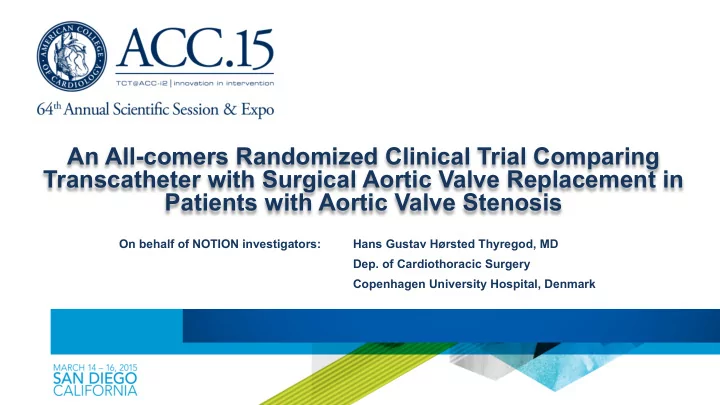

An All-comers Randomized Clinical Trial Comparing Transcatheter with Surgical Aortic Valve Replacement in Patients with Aortic Valve Stenosis On behalf of NOTION investigators: Hans Gustav Hørsted Thyregod, MD Dep. of Cardiothoracic Surgery Copenhagen University Hospital, Denmark Hans Gustav Hørsted Thyregod, MD Dep. of Cardiothoracic Surgery, Copenhagen University Hospital, Denmark
Funding • The Danish Heart Foundation
TAVR in Extreme-Risk Patients PARTNER TRIAL US COREVALVE EXTREME RISK STUDY Popma JJ et al, JACC 2014 Leon MB et al, NEJM 2010
TAVR in High-Risk Patients PARTNER TRIAL US COREVALVE HIGH RISK STUDY Months Smith CR et al, NEJM 2011 Adams DH et al, NEJM 2014
TAVR in Intermediate-Risk Patients All-cause mortality Propensity-score matched study Piazza et al, JACC 2014
Operative Risk and TAVR vs. SAVR Trials ? NOTION SURTAVI PARTNER II US COREVALVE PARTNER Low risk STS < 4% Intermediate risk 4 – 10% High risk 10% < - 15% Extreme risk > 15%
Nordic Aortic Valve Intervention (NOTION) Trial Compare TAVR vs. SAVR in patients > 70 years eligible for Objective: surgery (all-comers population) Composite rate of death from any cause, stroke or myocardial Primary outcome: infarction at 1 year (VARC II-defined) Safety and efficacy (NYHA), echocardiographic outcomes Secondary outcomes: (VARC II-defined) Design: Prospective, multicenter, non-blinded, randomized trial Enrollment period: December 2009 - April 2013
Participating Centers Sahlgrenska Rigshospitalet, University Copenhagen Hospital, University Hospital, Gothenburg, Copenhagen, Sweden Denmark Odense University Hospital, Odense, Denmark
Trial Investigators and CEC Principal Investigators: Peter Bo Hansen Lars Søndergaard Lars Willy Andersen Daniel Andreas Steinbrüchel Henrik Nissen Bo Juel Kjeldsen Co-investigators: Petur Petursson Hans Gustav Hørsted Thyregod Peter Skov Olsen Clinical Events Committee: Nikolaj Ihlemann Kristian Thygesen (chair), cardiologist Olaf Walter Franzen Bo Norrving, neurologist Thomas Engstrøm Torben Schroeder, vascular surgeon Peter Clemmensen
Enrollment Criteria Main inclusion criteria: Main exclusion criteria: • 70 years or older • Severe coronary artery disease • Severe aortic valve stenosis on • Severe other heart valve disease echocardiogram • Prior heart surgery • Expected to live more than 1 year • Indication for acute treatment • Anatomical suitable for both • Recent stroke or myocardial procedures infarction • Severe pulmonary or renal failure
Device and Access Routes Subclavian Self-expanding bio-prosthesis 4 valve sizes (annulus diameter 18-29 mm ) Transfemoral 18 Fr delivery system
Sample Size Determination Alternative hypothesis: TAVR is superior to SAVR regarding the composite rate of death from any cause, stroke or myocardial infarction after 1 year Sample Size Determination: 1:1 treatment allocation Expected rate SAVR = 15% Two-sided alpha = 0.05 Expected rate TAVR = 5% Power = 80% Trial Size: 280 patients
Primary Analysis Population • Intention-to-treat All randomized patients. Patients were analyzed according to randomization, regardless of whether a procedure was actually attempted or which prosthesis was actually implanted.
Trial Flow All randomized n=280 ITT TAVR ITT SAVR n=145 n=135 Crossover Crossover Died prior to procedure Died prior to procedure TAVR to SAVR to n=3 n=1 SAVR TAVR n=1 n=1 AT TAVR AT SAVR n=142 n=134 Not implanted n=2 Crossover TAVR to SAVR IMPLANTED IMPLANTED n=3 TAVR SAVR n=139 n=135
Trial Compliance ITT TAVR ITT SAVR N=145 N=135 100% 100% Baseline (145/145) (135/135) 96.4% 92.1% 1 Month Follow-Up (135/140) (116/126) 96.4% 93.6% 3 Months Follow-Up (135/140) (117/125) 98.5% 96.0% 1 Year Follow-Up (134/136) (119/124)
Baseline Characteristics TAVR SAVR Characteristic, % or mean ± SD n=145 n=135 p-value Age (yrs) 79.2 ± 4.9 79.0 ± 4.7 0.71 Male 53.8 52.6 0.84 Society of Thoracic Surgeons (STS) Score 2.9 ± 1.6 3.1 ± 1.7 0.30 STS Score < 4% 83.4 80.0 0.46 Logistic EuroSCORE I 8.4 ± 4.0 8.9 ± 5.5 0.38 NYHA class III or IV 48.6 45.5 0.61
Baseline Characteristics, cont. TAVR SAVR Characteristic, % or mean ± SD n=145 n=135 p-value Diabetes 17.9 20.7 0.55 Peripheral Vascular Disease 4.1 6.7 0.35 Prior Stroke 6.2 9.6 0.29 Chronic Obstructive Pulmonary Disease 11.7 11.9 0.97 Creatinine > 2 mg/dl 1.4 0.7 >0.99 Prior Myocardial Infarction 5.5 4.4 0.68 Prior Percutaneous Coronary Intervention 7.6 8.9 0.69
Primary Outcome* Composite rate of death from any cause, stroke or myocardial infarction 1 year after the procedure TAVR 13.1% vs. SAVR 16.3% Absolute difference -3.2%; p=0.43 (for superiority) *Intention-to-treat population
Death from Any Cause, Stroke or Myocardial Infarction at 1 Year in As-Treated Population
Death from Any Cause at 1 Year
All Stroke at 1 Year
Myocardial Infarction at 1 Year
Secondary Outcomes at 30 Days Outcome, % TAVR n=142 SAVR n=134 p-value Death, any cause 2.1 3.7 0.43 Death, cardiovascular 2.1 3.7 0.43 Bleeding, life-threatening+major 11.3 20.9 0.03 Cardiogenic shock 4.2 10.4 0.05 Vascular lesion, major 5.6 1.5 0.10 Acute kidney injury (stage II+III) 0.7 6.7 0.01 Stroke 1.4 3.0 0.37 TIA 1.4 0 0.17 Myocardial infarction 2.8 6.0 0.20 Atrial fibrillation 16.9 57.8 <0.001 Pacemaker 34.1 1.6 <0.001
Secondary Outcomes at 1 Year Outcome, % TAVR n=142 SAVR n=134 p-value Death, any cause 4.9 7.5 0.38 Death, cardiovascular 4.3 7.5 0.25 Stroke 2.9 4.6 0.44 TIA 2.1 1.6 0.71 Myocardial infarction 3.5 6.0 0.33 Atrial fibrillation 21.2 59.4 <0.001 Pacemaker 38.0 2.4 <0.001 Aortic valve re-intervention 0.0 0.0 na
NYHA Class in Survivors p=0.99 p=0.23 p=0.01
Aortic Valve Performance * ¡ * ¡ * ¡ * ¡ *p<0.001
Aortic Valve Regurgitation p<0.001 p<0.001
Conclusions • The NOTION trial was the first all-comers trial to randomize low-risk patients to TAVR or SAVR TAVR was safe and effective, but not superior to SAVR regarding the composite rate of death from • any cause, stroke or myocardial infarction after 1 year Procedural complications were different reflecting very different procedures • Larger EOA and lesser gradients with TAVR prosthesis, but more regurgitation • Long-term durability and morbidity data are required in lower risk patients •
Recommend
More recommend